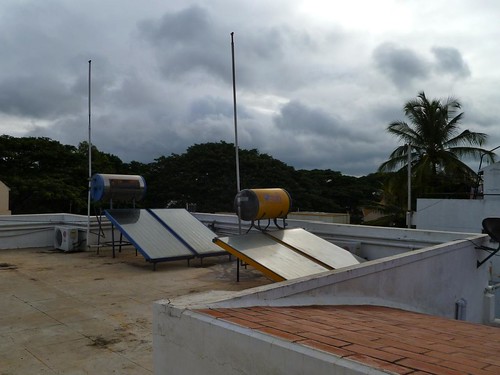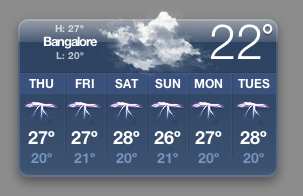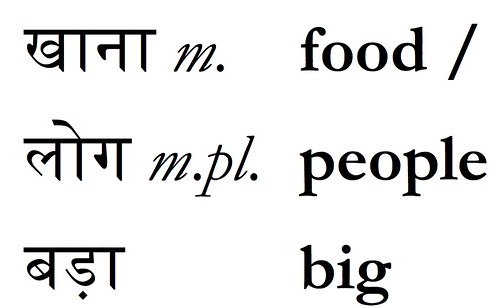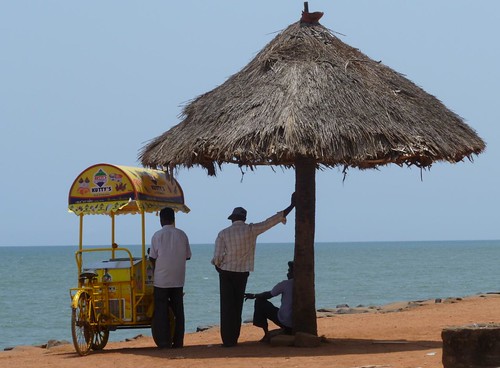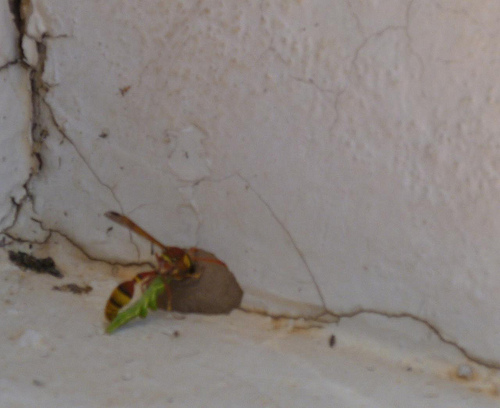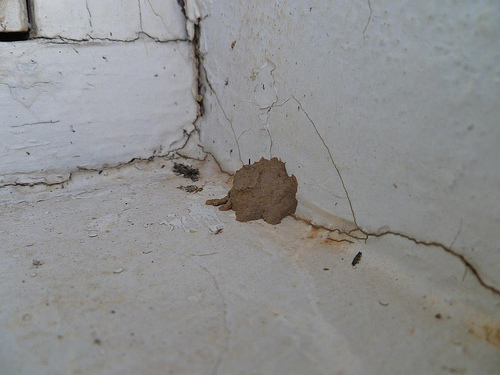Happy Solstice! Today is the Summer Solstice in the Northern hemisphere — as good a time as any to reflect on the last half year. Last Friday it was 6 months since I came out to India.
Obviously, daily life is now quite different in many ways. I now live in a big flat with 3 bedrooms, 3 bathrooms and 3 balconies. (But still practically zero furniture!) More to the point, I have space for a garden outside which is something I’ve been looking forward to regaining ever since losing it in 1998. For the first time in my life, I have a cleaner. Monday to Friday — and alternate Saturday mornings unfortunately — I catch an auto-rickshaw through the crazy traffic to work and back. I’ve been having Hindi lessons and can read and write some Devanagari script.
Some things are still the same, though, and I now realise how important it is to hang onto some aspects of your life when you teleport yourself to another continent and another culture. Bringing a laptop with 60GB of music on it has been quite important — playing a few favourite albums really provides a strong sense of the familiar if you need it. One thing that surprised me was how important food has been… I like Indian food very much — and even experimented with eating it every day for 3 weeks before I came out here just to see if I could do it! — but the hard bit has been when there was something I really wanted but just couldn’t find, and that happened a lot, especially in the first few months.
Proper cheese in particular has been really hard to find, as I expected it would be from my previous experiences in Malaysia and Japan… but good wholegrain bread is quite popular here in supermarkets and bakeries, and my local supermarket even sells Heinz Baked Beans for a fairly reasonable price. The first time I sat down to a proper home-made cheese and tomato sandwich here I was really surprised at how important something so mundane could apparently be. Since then I’ve found a few more home comforts, many of which are stupidly expensive — as almost everything that’s imported seems to be — and so they have to count as rare “treats”.
South Indian food is really great though — especially if you’re vegetarian — and I’m lucky that I’d been exposed to it back home due to living for 8 years in Leicester, where 20% of the population was South Asian, and I discovered aspects of the cuisine that hadn’t been on the radar in places I’d lived before: Chaats, Dosas, Dokla, Pani Puri and stuff. Since arriving here I’ve realised that was only the tip of the iceberg though, and even a single counter in the food-court in the mall next to work has a range way bigger than Bobby’s, my favourite Chaat House back in Leicester.
I’m so glad that the food is good. Several people I work with “don’t like spicy food”, which must make life difficult, even though I don’t think South Indian food is particularly hot compared with Northern cooking, but anyway.
Some things which seemed strange at first have now become familiar or even melted into the background altogether. I barely give a second look to cows wandering through rush-hour traffic, and I was surprised to find myself chilling out on the balcony recently one weekend, when I realised that all the drivers coming by my flat were honking their horns constantly — as everyone does, as if it’s the law — but they weren’t even registering and I was actually relaxing!
The famous Indian Head-Nod, a side-to-side wobble, was pretty indecipherable at the start, as it can mean any one of Yes, No, Maybe, I Agree, Thank You, and probably others I’ve not picked up on yet…. but I’ve come to love it and can usually work out what it means from the context. I haven’t started doing it myself yet, but that’s probably inevitable if I stay here long enough… after all it’s human nature to adopt the conventions everyone around you is using to communicate. I noticed quite early on that Indian English was somehow insinuating itself into my vocabulary — just as Scots did when I was living in Edinburgh, really — and recently it seems to have taken up residence in my brain without any invitation whatsoever. Just this morning I was taken aback to find myself writing in an e-mail “please revert to me if you have any doubts”, which means “please get back to me if you have any questions” (I hope!). I’ve even caught myself using the construct “X is there” which is particularly common, at least here in Bangalore. But I’m still trying to work out why locals seem to use “only” and “itself” in sentences where they obviously don’t mean what I would expect them to mean.
Not everything that I’ve become used to is welcome, though. I found the begging quite traumatic at first… being a white person sitting in an auto-rickshaw with no sides on it makes you an obvious target when you’re waiting at traffic lights, and when I first arrived I was quite shocked at how many beggars were hitting on me during the daily journey to work, which already seemed quite eventful at that point anyway — by turns hair-raising and surprisingly joyful (mostly depending on the driver and the state of the traffic). I was told that I shouldn’t give money to beggars who approach me in this way, because they were being run by gangs who would take the money off them anyway. Several people told me about women “renting” babies which they then drug, to put them to sleep, and then they carry them around all day while begging because it increases the takings that go to the gang-organisers. Sure enough, I’m accosted by women carrying unconscious 1-year olds in slings pretty much every day. It doesn’t make it any easier to look the other way though, when they’re tapping on your arm going “sah! sah!”.
The beggars I really can’t ignore are the tiny kids, wandering through the traffic on their own, with matted dusty hair. A cynic might say these are the gang’s biggest earners, I don’t know. The saddest thing on an everyday level has to be the plight of children. Every single day on my way to work I pass many small construction sites, there on the busy city streets, and they all look the same. There are big piles of sand, gravel and rebar (for re-inforcing concrete) next to the pavement. If there’s scaffolding, it’s made from small irregular tree-trunks. The construction workers themselves are families, which includes women and small children. I expect at some point I’ll probably find out they’re from a particular tribe or caste, but from the clothes of the women I see here I’m guessing they’re maybe from Rajasthan.
These construction families are usually living under some kind of tent made out of a blue tarp, or in a shed-sized temporary building made out of cinder blocks, or in the building that’s under construction itself. Sometimes they’ve found electricity from somewhere, and they often seem to have mobile phones. If it’s morning or evening, one of the women is usually cooking over a campfire on a black, cauldron-shaped pot. If it’s mid-day it’s not unusual to see everyone avoiding the blazing heat and crashed out sleeping on the gravel-pile or on the sand. On my way home from work I often see the men and boys in their underpants washing themselves under a hosepipe or in a big plastic barrel.
It’s seeing the children on these sites that really shocks, and I’m not sure if I’ll ever get used to this. Being a tiny, smiling, half-naked 2-year old playing in the sand is something I guess we can all relate to — but this sandpit is on a city street, a building site, it has been used as a toilet by the street dogs, and only a few feet away mum and dad are carrying bricks and cement around in wok-shaped metal bowls balanced on their heads.
Not quite so shocking, but perhaps the most worrying when you really think about it, is the number of children you see out and about who are working. South Asia has become somewhat notorious, perhaps even stereotyped, for children working in sweat-shops, but the kids I see every day just seem to be trying to make a living. Selling food, shining your shoes, hawking all kinds of plastic rubbish on the street…. they look street-wise and some of them are quite entrepeneurial and obviously bright, but the sad fact is simply that they’re not in school.
This quote from the World Bank stopped me in my tracks when I came across it:
“Close to 13.5 million underprivileged children in India are out of school and into child labour in order to earn a single meal in a day”.
Go back and read that again.
Everyone knows that India has one of the worst poverty problems of any country in the world, but it’s also well reported that it has one of the fastest-growing economies too. For any Indian child to escape the poverty trap and to be able to benefit from this growth means they need an education. I recently came across the Akshaya Patra Foundation, whose simple mission is to feed school-children every day, so that they don’t have to quit school to be able to earn enough money to eat. Needless to say I was happy to become a supporter.
When I think of the simple, basic things that so many people here in India are lacking — clean water, electricity, being able to read and write — it really puts into perspective the petty complaints that many, myself included, in “the West” might make. I find that perspective extremely valuable and humbling, on pretty much a daily basis. Which is probably doing me a lot of good. Not only that, but — to risk a possible cliché — the people here generally seem so incredibly positive and cheerful compared to people back home. Whether it’s the construction worker, the rickshaw driver I’ve just had an “argument” with over the fare, colleagues at work, a security guard outside a store, the small children living by the side of the road… there is so much smiling and laughing going on here that I find it remarkable, and I can’t help but be uplifted by it. Add to that also the gregarious Indian nature. Most people here seem to love being in groups and with friends, and it’s not unusual to see gangs of boys or young men walking down the street with their arms around each other, or holding hands, in a way that we “grow out of” in the west by the time we’re 10 or 11 years old. Adults still giggle too, and I find that surprisingly charming.
Of course, there’s a flip-side to all of this good-natured gregariousness, and the history of the last 70 years in this region is dotted with truly horrendous counter-examples of mobs going on the rampage, and of neighbours turning on neighbours. I’ve not seen any sign of violence in the short time I’ve been here… a few small incidences of road-rage at the most. But the willingness of the local government to shut everything down when there’s a potentially volatile political event — such as a Bandh, or the announcement of the ruling on the Ayodhya debate which came recently — perhaps hints at the way things can suddenly turn for the worse.
All in all, though, I’ve realised in the last few days that I’m feeling very happy here. Perhaps this is just short-lived relief, or a simple sense of achievement that I’ve managed to live for 6 months in a far-off land and I’m still pretty much myself, and haven’t yet died of some hideous tropical disease or gone insane.
Anyway for whatever reason… 6 months feels pretty good.
